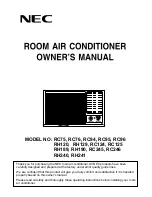
6
4. Installing the refrigerant piping
4.1. Precautions
For devices that use R32/R410A refrigerant
• Use alkylbenzene oil (small amount) as the refrigeration oil applied to the
flared sections.
• Use C1220 copper phosphorus for copper and copper alloy seamless pipes,
to connect the refrigerant pipes. Use refrigerant pipes with the thicknesses
specified in the table below. Make sure the insides of the pipes are clean
and do not contain any harmful contaminants such as sulfuric compounds,
oxidants, debris, or dust.
Warning:
When installing or relocating, or servicing the air conditioner, use only the
specified refrigerant written on outdoor unit to charge the refrigerant lines. Do
not mix it with any other refrigerant and do not allow air to remain in the lines.
If air is mixed with the refrigerant, then it can be the cause of abnormal high
pressure in the refrigerant line, and may result in an explosion and other hazards.
The use of any refrigerant other than that specified for the system will cause
mechanical failure or system malfunction or unit breakdown. In the worst case,
this could lead to a serious impediment to securing product safety.
ø6.35 thickness 0.8 mm
ø9.52 thickness 0.8 mm
ø12.7 thickness 0.8 mm
ø15.88 thickness 1.0 mm
• Do not use pipes thinner than those specified above.
4.2. Connecting pipes (Fig. 4-1)
• When commercially available copper pipes are used, wrap liquid and gas pipes
with commercially available insulation materials (heat-resistant to 100 °C or more,
thickness of 12 mm or more).
• Apply thin layer of refrigerant oil to pipe and joint seating surface before tightening
flare nut.
• Use 2 wrenches to tighten piping connections.
• Use refrigerant piping insulation provided to insulate indoor unit connections. Insulate
carefully.
• After connecting the refrigerant piping to the indoor unit, be sure to test the pipe
connections for gas leakage with nitrogen gas. (Check that there is no refrigerant
leakage from the refrigerant piping to the indoor unit.)
• Use flared nut installed to this indoor unit.
• In case of reconnecting the refrigerant pipes after detaching, make the flared part
of pipe re-fabricated.
B
Flare nut tightening torque
Copper pipe O.D.
(mm)
Flare nut O.D.
(mm)
Tightening torque
(N·m)
ø6.35
17
14 - 18
ø6.35
22
34 - 42
ø9.52
22
34 - 42
ø12.7
26
49 - 61
ø15.88
29
68 - 82
C
Apply refrigerating machine oil over the entire flare seat surface.
D
Use correct flare nuts meeting the pipe size of the outdoor unit.
Available pipe size
ZM35, 50
ZM60-140
Liquid side
ø6.35 Ο
—
—
ø9.52 Ο
Gas side
ø12.7 Ο
ø15.88 Ο
Ο : Factory flare nut attachment to the heat exchanger.
Warning:
• Be careful of flying flare nut! (Internally pressurized)
Remove the flare nut as follows:
1. Loosen the nut until you hear a hissing noise.
2. Do not remove the nut until the gas has been completely released (i.e.,
hissing noise stops).
3. Check that the gas has been completely released, and then remove the nut.
• When installing the unit, securely connect the refrigerant pipes before starting
the compressor.
A
Flare cutting dimensions
Copper pipe O.D.
(mm)
Flare dimensions
øA dimensions (mm)
ø6.35
8.7 - 9.1
ø9.52
12.8 - 13.2
ø12.7
16.2 - 16.6
ø15.88
19.3 - 19.7
Fig. 4-2
Fig. 4-1
A
B
C
D
A
E
F
B
Copper pipe O.D.
(mm)
B (mm)
Flare tool for R32/R410A
Clutch type
ø6.35 (1/4”)
0 - 0.5
ø9.52 (3/8”)
0 - 0.5
ø12.7 (1/2”)
0 - 0.5
ø15.88 (5/8”)
0 - 0.5
R0.4 - R0.8
45°± 2°
90°± 0.5°
E
Die
F
Copper pipe
RG79F156K01_EN.indd 6
12/13/2016 1:14:17 PM







































